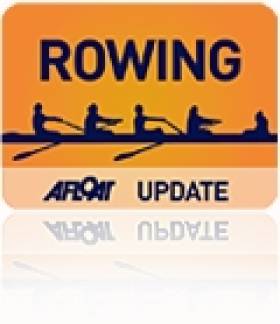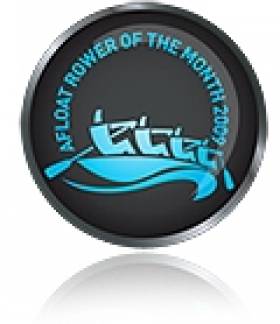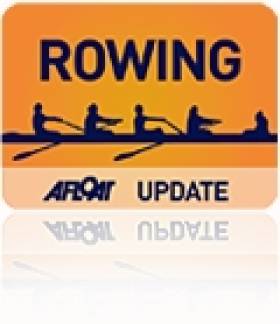Displaying items by tag: rowing
Queen’s Rule at Nottingham
Queen’s University pulled off a spectacular double at the British University Championships (Bucs) at Nottingham. The college won the Championship eights and the intermediate eights on Saturday, with good margins over second-placed Oxford Brookes in both cases. Irish adaptive crews also had good results at the Gavirate International Regatta in Italy, with the mixed coxed four taking silver on both days.
British University Championships, Nottingham (Selected Results):
Championship Eight: 1 Queen’s University, Belfast 5 min 58.22 sec; 2 Oxford Brookes 6:01.77, 3 Bristol 6:16.03.
Intermediate Eight: 1 Queen’s 5:44.52, 2 Oxford Brookes 5:46.79, 3 Durham 5:49.85.
Portadown Regatta, Saturday (Finals):
Eight – Junior 18: Methody bt RBAI 1/3 l. Junior 16: Portora bt Coleraine AI ½ l. Masters: Belfast RC bt Bann ¼ l.
Four – Junior 18, coxed: RBAI bt Coleraine AI 1 ½ l.
Sculling, Quadruple – Novice, coxed: Carrick-on-Shannon bt Bann easily. Junior 18: Methody bt Portadown 3l. Junior 16, coxed: Bann A bt Bann B 2l.
Double – Novice: Carrick-on-Shannon B bt Carrick-on-Shannon A canvas. Junior 18: Carrick-on-Shannon bt RBAI 3l. Junior 16: Carrick-on-Shannon bt Bann 2l. Masters: Belfast BC (F) bt Bann RC (D) easily
Single – Senior: Portadown (McIlveen) bt Lagan Scullers (Rankin) easily. Intermediate: Portadown (Hanna) bt Lagan Scullers (Rankin) easily. Novice: Portadown (Hanna) bt Carrick-on-Shannon (Little) 1 ½ l. Junior 18: RBAI (Beck) bt Carrick-on-Shannon (Cox) 3l. Junior 16: Carrick-on-Shannon (Aherne) bt Carrick-on-Shannon (Keaveney) 2 ½ l. Masters: Bann (Hamilton) bt Belfast BC (Gray) easily.
Women, Eight – Junior 18, Invitational: Portora bt Methody/Portadown 3l.
Four – Novice, coxed: Carrick-on-Shannon bt Queen’s easily.
Sculling, Quadruple – Novice, coxed: Carrick-on-Shannon bt Belfast RC easily. Junior 16, coxed: Portora bt Methody easily.
Double – Junior 18: Portadown A bt Portadown B ½ l. Junior 16: Portadown bt Carrick-on-Shannon 2 ½ l.
Single – Junior 18: Portadown (Toal) bt Portadown (Lindsay) easily.
Click this link for Irish Rowing detailsClick this link for the Latest Rowing News
Dublin rowing clubs Neptune and Commercial sit at the top of the new Rowing Ireland Grand League table following the Queen’s regatta in County Down.
The leading clubs after the second regatta are:
Neptune 219 points, Commercial 206, Skibbereen 192 points, UCD 171 pts, St. Michaels 150, Portora 117, Carrick on Shannon 102.
St Michaels, Limerick lead the men's senior category on 87 points, just one point ahead of Commercial on 86 points with UCD a close third on 81 points. UCD on 90 points now lead the women’s senior category ahead of Dublin University Ladies Boat Club on 56 points.
Skibbereen RC remain top of the junior men category closely followed by Dublin’s Neptune on 69 with Portora, Enniskillen and Neptune, Dublin topping the junior women on 63 and 62 points respectively.
Neptune, Dublin also lead in the overall best performing club category.
For full tables go to results at http://iaru.ie/main.php
Click this link for the Latest Rowing News
Ewing's Team Champion a New League
Brenda Ewing has been chosen as the Afloat Rower of the Month for April. In its two outings so far, at Skibbereen and Queen’s regattas, the Grand League series has been an outstanding success. Ewing, along with Pat McInerney and Mark Pattison, brought this radical idea to life and have worked tirelessly behind the scenes. She is honoured for this achievement.
Rower of the Month awards: The judging panel is made up of Liam Gorman, rowing correspondent of The Irish Times, President of Rowing Ireland Anthony Dooley and David O'Brien, Editor of Afloat magazine. Monthly awards for achievements during the year will appear on afloat.ie and the overall national award will be presented to the person who, in the judges' opinion, achieved the most notable results in, or made the most significant contribution to rowing during 2010. Keep a monthly eye on progress and watch our 2010 champions list grow.
Listen to the Podcast with Brenda Ewing below.
Hosts Take Big Prize at Queen's Regatta
Queen's University filled the top two places in the eights final at their own regatta in Castlewellan on Saturday. Their senior A and senior B crews came in ahead of Neptune's intermediates and two junior crews, from Bann and Portora. Senior crews from St Michael's and Commercial did not make the A Final. The women's eight final also showed how junior crews thrive in the new Grand League format, with Portora relegating UCD's senior women to second place.
Queen's University Regatta, Castlewellan, Saturday
Men, Eight: 1 Queen's A (sen) (W Howell, G Meek, E Mac Domhnaill, A
Mohammed, C Coyle, J Graham, M Butler, J Mitchell; cox: H Rhys-Davies)
4:09.24, 2 Queen's B (sen) 4:14.92, 3 Neptune (inter) 4:17.40, 4 Bann
(jun) 4:22.65. B Final: St Michael's 5:05.19. Novice, Junior: 1 UCD
(nov) 5:01.47, 2 Commercial (nov) 5:12.45, 3 UCD (nov) 5:14.11, 4 St
Joseph's (jun 16) 5:16.81. Masters: 1 Belfast RC (men); 4 Belfast RC
(women)
Four: 1 Galway (sen) 5:09.60, 2 Queen's 5:12.26 (sen), 3 Garda (sen)
5:23.24. Four, coxed: 1 Galway RC (inter) 5:10.97, 2 Neptune (inter)
5:12.65, 3 St Michael's (senior), 4 Portora (jun) 5:16.81. Masters:
City of Derry (men); 3 Belfast RC. Novice, Junior: 1 Queen's A (nov)
5:50.29, 2 Commercial (nov) 5:52.92, 3 Garda 6:03.32, 4 Bann (jun 16)
6:06.32, 5 Neptune (jun) 6:03.99. B Final: UCD (nov) 5:55.60.
Pair: 1 St Michael's (S Lynch, K O'Connor; sen) 5:34.06, 2 Bann A
(jun) 5:40.59, 3 Bann B (jun) 5:44.35.
Sculling – Quadruple: 1 Queen's (sen) 5:11.65, 2 Neptune (jun)
5:19.69, 3 Portadown (sen) 5:34.65. Novice, Junior: 1 Commercial (jun)
6:40.93, 2 Carrick-on-Shannon (nov) 6:48.70, 3 Bann (jun 16) 6:56.26.
B Final: Methodist (jun 16) 6:18.72. C Final: Bann (nov) 6:30.42.
Double: 1 St Michael's (S Lynch, K O'Connor; sen), 2 Commercial (sen)
5:39.71, 3 Carrick-on-Shannon (jun) 5:57.94; 5 City of Derry (inter)
6:13.94. B Final: Portora (jun) 7:05.17. Novice, Junior: 1 Commercial
(jun 16) 6:04.13, 2 Athone (jun 16) 6:08.58, 3 Carrick-on-Shannon (jun
16) 6:15.82; 5 Coleraine AI (jun) 6:18.16. B Final: Athlunkard (jun)
6:21.85; 3 Carrick-on-Shannon (nov) 6:37.35. C Final: Belfast RC (jun)
6:35.97.
Single: 1 City of Derry (D Donaghy, sen) 5:43.97, 2 Garda (Duane, sen)
5:49.21, 3 Belfast BC (Darby, lightweight) 5:55.03, 4 Commercial
(Folan, inter) 5:56.11; 6 Carrick-on-Shannon (Cox, jun) 5:59.00.
Novice, Junior: 1 Fitzwilliam College, Cambridge (Marron, nov)
6:02.64, 2 Carrick-on-Shannon A (Aherne, jun 16) 6:10.41, 3 Neptune
(O'Hara, jun).
Women
Eight: 1 Portora (junior) (L Dempster, A McCann, M Henry, AM Maguire,
A Hamilton, H Nixon, J Russell, K Cromie; cox: C St Ledger) 5:23.24, 2
UCD (sen) 5:28.50, 3 Commercial (junior) 5:40.73. Novice, Junior: 1
Queen's (nov) 5:47.40, 2 UCD (nov) 5:47.86, 3 Methodist (jun) 5:54.82,
4 Portora (jun 16) 6:18.12.
Four: 1 UCD (sen) 6:02.64, 2 Commercial (sen) 6:06.91, 3 Portora (jun)
6:11.88. Four, coxed: 1 UCD (inter) 5:48.92, 2 Queen's (inter)
6:06.01, 3 Commercial 6:12.81. Novice, Junior: 1 Queen's (nov)
5:57.37, 2 UCD (nov) 6:03.12, 3 Portora (jun 16).
Pair: 1 Neptune (sen) 6:44.68, 2 Portora (jun) 6:58.97.
Sculling
Quadruple: 1 Portora (jun) 5:39.04, 2 Bann (jun) 5:49.53, 3 Neptune
(jun) 6:01.62. Novice, Junior: 1 Neptune (jun 16) 6:01.79, 2
Killorglin (jun 16) 6:05.57, 3 Galway RC 6:25.06; 5 Carrick-on-Shannon
(nov) 6:48.93.
Double: 1 City of Derry (inter) 6:04.64, 2 Neptune (inter) 6:11.33, 3
Belfast RC 6:16.98, 4 Bann (jun) 6:31.51.
Novice, Junior: 1 Garda (nov) 6:43.73, 2 Neptune (jun 16) 6:52.00, 3
Portadown (jun 16) 7:15.34.
Single: 1 Killorglin (M Dukarska; inter) 6:35.20, 2 Commercial (Quinn;
lightweight) 6:49.11, 3 Belfast (Beringer, inter) 7:04.70.B Final:
Belfast RC (Duncan, inter) 7:13.69, 2 Neptune (McEneff, jun) 7:22.73.
Novice, Junior: 1 Killorglin (Crowley; jun 16) 7:26.80, 2 Neptune
(Byrne, jun 16) 7:32.75, 3 St Michael's (O'Sullivan) 7:33.71. B Final:
St Michael's (jun) 7:45.66.
Up to eight hundred rowers from twenty eight clubs will compete in Rowing Ireland’s second Grand League Regatta which takes place next Saturday at the Queen's Regatta in Castlewellan , Co Down. The leading clubs after the first Grand League Regatta of the season, which was held at the National Rowing Centre in Cork two weeks ago are:
Skibbereen 192 points, UCD 96 pts, Lee Rowing Club, Cork 86 pts and Commercial RC Dublin 75pts.
.
UCD lead the Men's Senior Category ahead of Commercial, while Dublin University Ladies Boat Club lead the Women's Senior Category over NUI Galway.
Cork Clubs dominate the junior ranking with Skibbereen RC on top in both Junior Men’s and Women’s categories.
In the Junior Women, Skibbereen RC lead Shandon BC with Presentation College BC holding down the number two spot in the Junior Men’s category.
Rowing Ireland spokesperson, Pat McInerney said, “The top senior men’s race this weekend sees Queens up against UCD, Commercial, St Michaels, Neptune and several junior crews including the Bann juniors who placed very well at the recent London schools head.”
Click this link for the Latest Rowing News
National Organisations
National Organisations
There are a number of different organisations established in Ireland to manage the marine leisure sector and these stakeholders are an important part in the future growth of the sector that is arguably worth 700 million euro per annum to the Exchequer.
The main organisations – including some in the UK – are:
Cruising Association of Ireland – The Cruising Association of Ireland was set up with the aim of working with the Irish Sailing Association and the Royal Yachting Association Northern Ireland for the promotion and encouragement of cruising and of social union among its members.
Heritage Boat Association – The Heritage Boat Association’s aspiration is to protect, promote and celebrate the floating heritage on the inland waterways of Ireland.
Inland Waterways Association – A voluntary body formed in 1954 of inland waterways enthusiasts, the IWA advocates the use, maintenance, protection, restoration and improvement of the inland waterways of Ireland.
Irish Amateur Rowing Union/Rowing Ireland – The IARU/Rowing Ireland is the governing body for rowing in Ireland and represents over 100 clubs across Ireland. Rowing is one of Ireland's most successful sports, having won multiple World Championships over the last decade.
Irish Coast Guard (IRCG) (Garda Cósta na hÉireann) – The Irish Coast Guard is part of the Department of Transport. The Irish Search and Rescue Region, which includes most of the Republic of Ireland and parts of Northern Ireland, is the area over which the coast guard has authority. This area is bounded by the UK Search and Rescue Region.
Irish Cruiser Racer Association – ICRA can be contacted via Commodore Fintan Cairns at [email protected] or the Secretary Denis Kiely at [email protected]
Irish Disabled Sailing Association/Sailforce – Sailforce is a new campaign established by the Irish Disabled Sailing Association (IDSA) to highlight the achievements and activities of their current membership and to introduce members of the general public to the concept of sailing as a viable sport for the disabled.
Irish Marina Operators Association – The IMOA is an associate group of the Irish Marine Federation (IMF) focussing exclusively on the needs of marina operators. Membership of IMOA currently represents coastal marinas, but will eventually be open to Ireland's inland waterway marinas.
Irish Marine Federation – The IMF is the national organisation representing both commercial and leisure sectors of the marine industry in Ireland.
Irish Maritime Law Association – The Irish Maritime Law Association was formed at a meeting in the Shelbourne Hotel in Dublin on 23 May 1963.
Irish Rowing Union – The IARU is the governing body for rowing in Ireland and represents over 100 Clubs across Ireland. Rowing is one of Ireland’s most successful sports, having won multiple World Championships over the last decade.
Irish Sailing Association – The ISA is the national governing body for all forms of recreational and competitive activities involving sail and engine powered craft in Ireland.
Irish Sea Shipping – Online Shipping Magazine with shipping news and views from the Irish and Celtic Seas since 1995.
Irish Ships & Shipping – Irish Shipping Ltd. was set up in 1941 to ensure Ireland could import and export essential goods during World War II. Britain had decided that it could no longer put its ships and men at risk by supplying a country had had decided to remain neutral. So after a meeting held at Earlsfort Terrace, Dublin, on the 21st of March 1941, a National Shipping Company was formed called 'Irish Shipping Ltd.' .
Irish Underwater Council – The Irish Underwater Council is the national governing body for recreational underwater sports in Ireland. It was founded in 1963 to organise and promote sport scuba diving and snorkeling. At that time there were only six clubs but the sport has expanded over the years and today encompasses 84 clubs distributed all over Ireland.
Irish Water Safety – Irish Water Safety is the statutory body established to promote water safety in Ireland. Their role is to educate people in water safety best practices and develop public awareness campaigns to promote necessary attitudes, rescue skills and behaviour to prevent drownings and water-related accidents.
Marine Casualty Investigation Board – The function of the MCIB is to carry out investigations into marine casualties that take place in Irish waters or involve Irish registered vessels. The main purpose of the Board's investigations is to establish the cause or causes of a marine casualty with a view to making recommendations to the Minister for Transport for the avoidance of similar marine casualties. It shall not be the purpose of an investigation to attribute blame or fault.
Met Éireann: Irish Meteorological Service – Met Éireann, the Irish National Meteorological Service, is part of the Department of the Environment, Heritage and Local Government. It is the leading provider of weather information and related services for Ireland.
North West Charter Skippers Association – The North West Charter Skippers Organisation was inaugurated in January 2002, and was formed to enhance and develop Charter Boat Services through the interchange of Information through the promotion of a fleet of fully licensed, insured, and well-equipped Modern Sea Angling Vessels adopting best practice and providing a high quality service in Sea Angling and general tourism charters to the Northwest Coast of Ireland – 'Service with Safety'
Professional Association of Diving Instructors – PADI is the world’s leading scuba diving training organisation. With more than forty years experience and 5,300 dive shops and resorts worldwide, PADI training materials and services let you experience scuba diving from nearly anywhere.
RNLI Ireland – The RNLI is a registered charity that saves lives at sea. It provides a 24-hour lifeboat search and rescue service 100 nautical miles out from the coast of Ireland and the UK. The RNLI relies on voluntary contributions and legacies for its income.
Royal Yachting Association – The RYA is the national body in the UK for all forms of boating, including dinghy and yacht racing, motor and sail cruising, ribs and sports boats, powerboat racing, windsurfing, inland cruising and narrowboats, and personal watercraft.
Royal Yachting Association Northern Ireland – The RYA is the national body in the UK for all forms of boating, including dinghy and yacht racing, motor and sail cruising, RIBs and sportsboats, powerboat racing, windsurfing, inland cruising and narrowboats, and personal watercraft. The RYANI are their Northern Irish branch.
Union Internationale Motonautique/International Powerboat Racing Club – The UIM is the international governing body of power boating and is recognized as such by the International Olympic Committee. It is also a member of the General Association of International Sports Federations, and the Association of the IOC Recognized International Sports Federations. The sport governs all power boating disciplines including aqua bike, circuit, offshore, pleasure navigation and radio-controlled.
Waterways Ireland – one of the six North/South Implementation Bodies established under the British Irish Agreement in 1999, Waterways Ireland has responsibility for the management, maintenance, development and restoration of inland navigable waterways principally for recreational purposes. The waterways under the remit of the body are the Barrow Navigation, the Erne System, the Grand Canal, the Lower Bann, the Royal, the Shannon-Erne Waterway and the Shannon Navigation.

































































